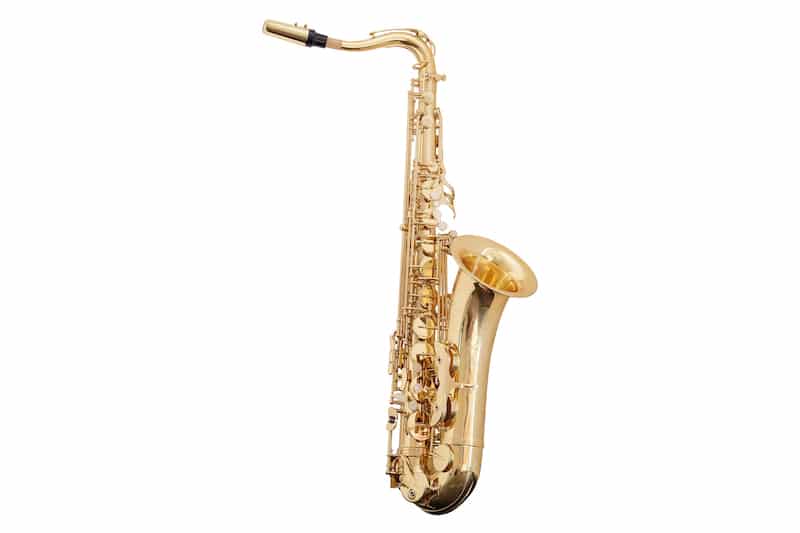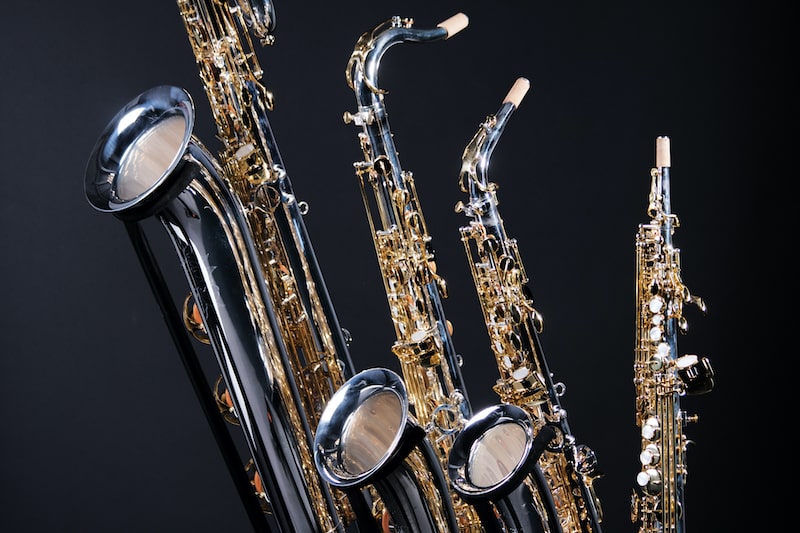A relatively young instrument with its roots in 19th Century France, the saxophone is now most commonly associated with jazz. However, it is also used in classical music, pop, rock and roll, funk, ska, and various other genres.
In this article, we’ll take a look at the history of the saxophone and how it became one of the most popular instruments in the world. Let’s get started.
Ancestors of the Saxophone

The saxophone does not have an obvious predecessor in the way that some instruments do.
For example, the Shawm, a popular Renaissance instrument, obviously evolved into the modern-day oboe, while the trombones we see today are clearly descended from sackbuts.
That said, the saxophone is certainly related to the other members of the modern woodwind family.
The clarinet, with its similar single-reed and mouthpiece setup, is its closest cousin, while the sax’s fingering system is very similar to the flute and recorder.
It has been suggested that the ophicleide, a tuba-like instrument of the Romantic period, is a direct ancestor of the saxophone.
It has a brass-style mouthpiece, but its conical bore and woodwind-style keys are similar to the sax, although this link has been disputed.
Other instruments that could be considered brass-woodwind hybrids include the serpent, an ancestor of the tuba, and the cornett, which dates back to the Medieval period.
Both of these have cup mouthpieces but are made of wood and have finger holes rather like a recorder.
Adolphe Sax and the Invention of the Saxophone

The saxophone was invented in the early 1840s and patented in 1846.
The mid-19th Century might sound like a long time ago, but compared to plenty of other instruments, that makes it something of a baby, relatively speaking.
For example, the recorder dates back to the Middle Ages, the clarinet was invented in around 1700, while wooden flutes have been around for millenia.
The saxophone is also rather unusual in that we can pinpoint a single, definitive inventor.
That man is Adolphe Sax, a Belgian who resided in France and whom the instrument is of course named after.
Sax’s father, Charles Joseph Sax, was an esteemed instrument maker who worked for the King of the Netherlands for a time.
After studying at the Royal Conservatory of Brussels, Adolphe began working on new instruments of his own and moved to Paris.
It was whilst attempting to modify and improve the bass clarinet that he began trying to make an instrument that combined a flute and clarinet-esque agility and ability to play fast and tricky passages, with the horn-like projection of the brass family.
The result was the saxophone.
The Saxophone Family

The four most commonly-played saxophones, from lowest to highest, are
- baritone
- tenor
- alto
- soprano
But there are lots of other types of saxophones and you’ll also occasionally see the sopranino and the sopranissimo (also known as the soprillo), which are both pitched higher than the soprano, and the bass, contrabass and even subcontrabass saxophones, which are the largest and lowest-pitched members of the family.
These saxophones are all transposing instruments, with the alto and baritone saxophones pitched in E flat, while the tenor and soprano are in B flat.
This means that if an alto or baritone plays a C, it will sound as an E flat on the piano, while a tenor or soprano’s C will sound as a B flat on the piano.
Adolphe Sax originally designed 14 members of the saxophone family, including models in the keys of F and C as well, but the series of B flat and E flat instruments soon became the go-to.
One notable exception was the C melody saxophone, a concert pitch instrument that sounded higher than the tenor and lower than the alto.
It was popular during the early part of the 20th Century, with a major selling point being its ability to read the same music as the piano, violin or flute without transposing, but its popularity declined from the 1930s onwards and it is now rarely seen.
Rudy Wiedoeft was a virtuoso C melody saxophonist whose novelty-tinged recordings were popular in the 1910s:
Early Usage and the Saxophone in Classical Music
Adolphe Sax originally intended the saxophone to become a part of the orchestra, and the instrument was initially heralded by the composer Hector Berlioz.
It was quickly adopted by military bands but never really took off as an orchestral instrument.
That said, there were a number of works written by major composers during the late 19th and 20th Centuries to feature the saxophone – either as a solo instrument or simply as part of the ensemble – and professional orchestras will often draft in one or more saxophone specialists when playing these pieces today.
Examples include Debussy’s Rapsodie pour Orchestre et Saxophone and Alexander Glazunov’s Concerto in E flat major:
After a period of declining interest in the saxophone in Europe, Marcel Mule formed a saxophone quartet in the late 1920s and set about arranging, transcribing and commissioning repertoire for the group.
Typically composed of soprano, alto, tenor and baritone, the sax quartet is now a popular chamber music format for classical saxophonists:
Mule later began teaching at the Paris Conservatoire, establishing the saxophone as a serious classical instrument.
The Saxophone in Jazz
The saxophone started to become popular in the United States in the early 20th Century, where it was often used as a novelty instrument by vaudeville performers.
Jazz began in New Orleans in the 1910s, but saxophones did not initially have a big role to play, with the trumpet leading a typical band, and clarinet and trombone completing the frontline.
Prominent early exceptions included Frankie Trumbauer, who played C melody saxophone on seminal recordings with Bix Beiderbecke, and Sidney Bechet, whose wide vibrato on the soprano sounds like no one else:
Coleman Hawkins popularized the tenor saxophone as a jazz instrument in the 1920s and ‘30s, and soon, the Swing Era meant that wildly popular big bands, each featuring multiple saxophonists, were everywhere.
From then on, the saxophone was involved in every major development in jazz: Charlie Parker’s thrilling bebop, John Coltrane’s spiritually-charged modal jazz, Ornette Coleman’s revolutionary free jazz, Stan Getz’s lyrical contributions to the Bossa Nova craze, and Michael Brecker’s supercharged fusion.
Today, legions of young saxophonists study jazz at university and conservatory level in a bid to continue this tradition.
The Saxophone in Popular Music
The saxophone’s ability to play expressively made it a perfect fit for the rhythm and blues bands of the 1940s, with players like Louis Jordan playing catchy, riff-based solos:
This music would influence rock and roll and ska and funk, genres which would often include small horn sections as part of the band.
The pop music of the 1970s and ‘80s would often include a saxophone solo as an instrumental interlude between vocal verses.
Manufacturers and Models
In the 1880s and 1890s the American companies C.G. Conn and Buescher began making some of the first mass-produced saxophones, with standardized, increasingly ergonomic design gradually being established during the 1930s and ‘40s.
Martin, King and Selmer were also popular manufacturers during this period.
Henri Selmer purchased the original Adolphe Sax factory in 1928 and the brand continues to craft market-leading instruments just outside of Paris.
The Selmer Mark VI is perhaps the most iconic model in saxophone history, and many modern saxophones are based upon its design.
Manufactured between 1954 and the mid-1970s, it was the horn of choice for legendary jazz musicians including John Coltrane, Sonny Rollins, Phil Woods and Stan Getz, with vintage Mark VIs now highly sought after.
Other renowned manufacturers now include the Japanese companies Yamaha and Yanagisawa, the German brand Keilwerth, and Borgani, a boutique Italian maker.
Meanwhile, the likes of Trevor James, Jupiter and Elkhart largely focus on making saxophones for the student market.
Summing up the Saxophone’s History
It might not have become a core part of the orchestra in the way that Adolphe Sax hoped it would, but in a relatively short space of time the versatile saxophone has become one of the world’s most popular instruments.
Its adoption as a jazz instrument saw it involved in the creation of some of the 20th Century’s most important music, while it has also played vital roles in music within the classical and pop spheres and beyond.
Thanks for reading!

